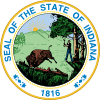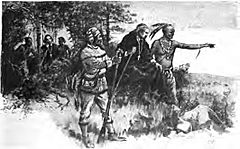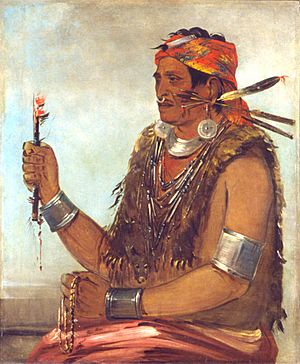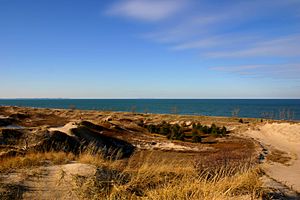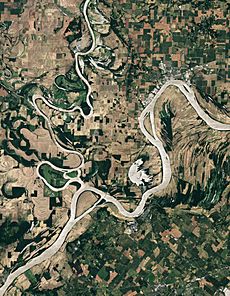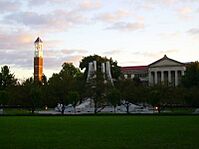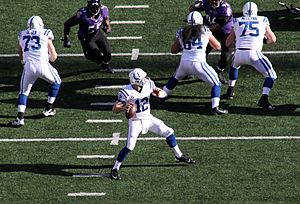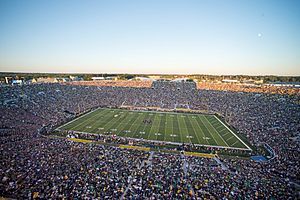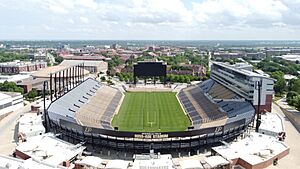Indiana facts for kids
Quick facts for kids
Indiana
|
|||
|---|---|---|---|
| State of Indiana | |||
|
|||
| Nickname(s):
"The Hoosier State"
|
|||
| Motto(s):
"Crossroads of America"
|
|||
| Anthem: "On the Banks of the Wabash, Far Away" |
|||

Location of Indiana within the United States
|
|||
| Country | United States | ||
| Before statehood | Indiana Territory | ||
| Admitted to the Union | December 11, 1816 (19th) | ||
| Capital (and largest city) |
Indianapolis | ||
| Largest county or equivalent | Marion | ||
| Largest metro and urban areas | Indianapolis | ||
| Legislature | General Assembly | ||
| • Upper house | Indiana Senate | ||
| • Lower house | Indiana House of Representatives | ||
| Judiciary | Indiana Supreme Court | ||
| U.S. senators |
|
||
| U.S. House delegation |
|
||
| Area | |||
| • Total | 36,418 sq mi (94,321 km2) | ||
| • Land | 35,868 sq mi (92,897 km2) | ||
| • Water | 550 sq mi (1,424 km2) 1.5% | ||
| Area rank | 38th | ||
| Dimensions | |||
| • Length | 278 mi (432 km) | ||
| • Width | 149 mi (232 km) | ||
| Elevation | 700 ft (210 m) | ||
| Highest elevation | 1,257 ft (383 m) | ||
| Lowest elevation
(Confluence of Ohio River and Wabash River)
|
320 ft (97 m) | ||
| Population
(2024)
|
|||
| • Total | |||
| • Rank | 17th | ||
| • Density | 189/sq mi (73.1/km2) | ||
| • Density rank | 16th | ||
| • Median household income | $69,500 (2023) | ||
| • Income rank | 37th | ||
| Demonym(s) | Hoosier | ||
| Language | |||
| • Official language | English | ||
| Time zones | |||
| 80 counties | UTC−05:00 (Eastern) | ||
| • Summer (DST) | UTC−04:00 (EDT) | ||
| 12 counties | UTC−06:00 (Central) | ||
| • Summer (DST) | UTC−05:00 (CDT) | ||
| USPS abbreviation |
IN
|
||
| ISO 3166 code | US-IN | ||
| Traditional abbreviation | Ind. | ||
| Latitude | 37° 46′ N to 41° 46′ N | ||
| Longitude | 84° 47′ W to 88° 6′ W | ||
| Bird | Northern cardinal (Cardinalis cardinalis) |
|---|---|
| Flower | Peony (Paeonia) |
| Tree | Tulip tree (Liriodendron tulipifera) |
| Insect | Say's firefly (Pyractomena angulata) |
Indiana (![]() i/ˌɪndiˈænə/ IN-dee-AN-ə) is a state in the Midwestern region of the United States. It borders Lake Michigan to the northwest, Michigan to the north and northeast, Ohio to the east, the Ohio River and Kentucky to the south and southeast, and the Wabash River and Illinois to the west. Nicknamed "the Hoosier State", Indiana is the 38th-largest by area and the 17th-most populous of the 50 states. Its capital and largest city is Indianapolis. Indiana was admitted to the United States as the 19th state on December 11, 1816.
i/ˌɪndiˈænə/ IN-dee-AN-ə) is a state in the Midwestern region of the United States. It borders Lake Michigan to the northwest, Michigan to the north and northeast, Ohio to the east, the Ohio River and Kentucky to the south and southeast, and the Wabash River and Illinois to the west. Nicknamed "the Hoosier State", Indiana is the 38th-largest by area and the 17th-most populous of the 50 states. Its capital and largest city is Indianapolis. Indiana was admitted to the United States as the 19th state on December 11, 1816.
Various indigenous peoples inhabited what would become Indiana for thousands of years, some of whom the U.S. government expelled between 1800 and 1836. Indiana received its name because the state was largely possessed by native tribes even after it was granted statehood. Since then, settlement patterns in Indiana have reflected regional cultural segmentation present in the Eastern United States; the state's northernmost tier was settled primarily by people from New England and New York, Central Indiana by migrants from the Mid-Atlantic states and adjacent Ohio, and Southern Indiana by settlers from the Upland South, particularly Kentucky and Tennessee.
Indiana has a diverse economy with a gross state product of $352.62 billion in 2021. It has several metropolitan areas with populations greater than 100,000 and a number of smaller cities and towns. Indiana is home to professional sports teams, including the NFL's Indianapolis Colts and the NBA's Indiana Pacers. The state also hosts several notable competitive events, such as the Indianapolis 500, held at Indianapolis Motor Speedway.
Contents
Etymology

The state's name means "Land of the Indians", or simply "Indian Land".
A resident of Indiana is officially known as a Hoosier.
History
First inhabitants
The first inhabitants in what is now Indiana were the Paleo-Indians, who arrived about 8000 BC after the melting of the glaciers at the end of the Ice Age.
Divided into small groups, the Paleo-Indians were nomads who hunted large game such as mastodons.
The Hopewell people began developing long-range trade of goods.They developed highly productive cultivation and adaptation of agriculture, growing such crops as corn and squash. This period ended around 1000 AD.
The Mississippian culture emerged, lasting from 1000 until the 15th century, shortly before the arrival of Europeans. During this stage, the people created large urban settlements designed according to their cosmology, with large mounds and plazas defining ceremonial and public spaces. The concentrated settlements depended on the agricultural surpluses. One such complex was the Angel Mounds. They had large public areas such as plazas and platform mounds, where leaders lived or conducted rituals.
Mississippian civilization collapsed in Indiana during the mid-15th century for reasons that remain unclear. The historic Native American tribes in the area at the time of European encounter spoke different languages of the Algonquian family. They included the Shawnee, Miami, and Illini. Later they were joined by refugee tribes from eastern regions including the Delaware who settled in the White and Whitewater River Valleys.
European exploration and sovereignty
In 1679 the French explorer René-Robert Cavelier, Sieur de La Salle was the first European to cross into Indiana after reaching present-day South Bend at the Saint Joseph River.
French-Canadian fur traders soon arrived, bringing blankets, jewelry, tools, whiskey and weapons to trade for skins with the Native Americans. By 1702, Sieur Juchereau established the first trading post near Vincennes. In 1715 Sieur de Vincennes built Fort Miami at Kekionga, now Fort Wayne.
In 1717, another Canadian, Picote de Beletre, built Fort Ouiatenon on the Wabash River, to try to control Native American trade routes from Lake Erie to the Mississippi River. In 1732 Sieur de Vincennes built a second fur trading post at Vincennes. French Canadian settlers, who had left the earlier post because of hostilities, returned in larger numbers. In a period of a few years, British colonists arrived from the East and contended against the Canadians for control of the lucrative fur trade. Fighting between the French and British colonists occurred throughout the 1750s as a result.
The Native American tribes of Indiana sided with the French Canadians during the French and Indian War (also known as the Seven Years' War). With British victory in 1763, the French were forced to cede all their lands in North America east of the Mississippi River and north and west of the colonies to the British crown.
The tribes in Indiana did not give up; they destroyed Fort Ouiatenon and Fort Miami during Pontiac's Rebellion. The British royal proclamation of 1763 designated the land west of the Appalachians for Indian use, and excluded British colonists from the area, which the Crown called Indian Territory.
In 1775 the American Revolutionary War began as the colonists sought more self-government and independence from the British. At the end of the war, through the Treaty of Paris, the British crown ceded their claims to the land south of the Great Lakes to the newly formed United States, including American Indian lands.
The frontier
In 1787 the US defined present-day Indiana as part of its Northwest Territory.
Starting with the Battle of Fallen Timbers in 1794 and Treaty of Greenville, 1795, Indian titles to Indiana lands were extinguished by usurpation, purchase, or war and treaty. About half the state was acquired in the St. Mary's Purchase from the Miami in 1818. Purchases weren't complete until the Treaty of Mississinwas in 1826 acquired the last of the reserved Indian lands in the northeast
In 1810 the Shawnee chief Tecumseh and his brother Tenskwatawa encouraged other tribes in the territory to resist European settlement. Tensions rose and the US authorized Harrison to launch a preemptive expedition against Tecumseh's Confederacy; the US gained victory at the Battle of Tippecanoe on November 7, 1811. Tecumseh was killed in 1813 during the Battle of Thames. After his death, armed resistance to United States control ended in the region.
Most Native American tribes in the state were later removed to west of the Mississippi River in the 1820s and 1830s after US negotiations and purchase of their lands.
Statehood and settlement
President James Madison approved Indiana's admission into the union as the nineteenth state on December 11, 1816. In 1825, the state capital was moved from Corydon to Indianapolis.
Many European immigrants went west to settle in Indiana in the early 19th century. The largest immigrant group to settle in Indiana were Germans, as well as numerous immigrants from Ireland and England.
Civil War
During the American Civil War, Indiana became politically influential and played an important role in the affairs of the nation. As the first western state to mobilize for the United States in the war, Indiana had soldiers participating in all of the major engagements. The only Civil War conflicts in Indiana were the Newburgh Raid, the capture of Newburgh, Indiana, and the Battle of Corydon, which occurred during Morgan's Raid.
Indiana remained a largely agricultural state; post-war industries included food processing, such as milling grain, distilling it into alcohol, and meatpacking; building of wagons, buggies, farm machinery, and hardware.
Early 20th century

With the onset of the industrial revolution, Indiana industry began to grow at an accelerated rate across the northern part of the state.
The Indiana Gas Boom led to rapid industrialization during the late 19th century by providing cheap fuel to the region.
In the early 20th century, Indiana developed into a strong manufacturing state with ties to the new auto industry. The construction of the Indianapolis Motor Speedway and the start of auto-related industries were also related to the auto industry boom.
Modern era
The auto, steel and pharmaceutical industries topped Indiana's major businesses. Indiana's population continued to grow during the years after the war, exceeding five million by the 1970 census.
Geography
With a total area (land and water) of 36,418 square miles (94,320 km2), Indiana ranks as the 38th largest state in size. The state has a maximum dimension north to south of 250 miles (400 km) and a maximum east to west dimension of 145 miles (233 km). The state's geographic center (39° 53.7'N, 86° 16.0W) is in Marion County.
Located in the midwestern United States, Indiana is one of eight states that make up the Great Lakes Region. Indiana is bordered on the north by Michigan, on the east by Ohio, and on the west by Illinois, while Lake Michigan borders Indiana on the northwest and the Ohio River separates Indiana from Kentucky on the south.
The average altitude of Indiana is about 760 feet (230 m) above sea level. The highest point in the state is Hoosier Hill in Wayne County at 1,257 feet (383 m) above sea level. The lowest point at 320 feet (98 m) above sea level is located in Posey County, where the Wabash River flows into the Ohio River.
The state includes two natural regions of the United States, the Central Lowlands and the Interior Low Plateaus. The till plains make up the northern and central allotment of Indiana. Much of its appearance is a result of elements left behind by glaciers.
Central Indiana is mainly flat with some low rolling hills (except where rivers cut deep valleys through the plain, like at the Wabash River and Sugar Creek) and soil composed of glacial sands, gravel and clay, which results in exceptional farmland.
Northern Indiana is also very similar except for the presence of higher and hillier terminal moraines and many kettle lakes in some regions. In northwest Indiana there are various sand ridges and dunes, some reaching nearly 200 feet in height. These are located along the Lake Michigan shoreline and also inland to the Kankakee River Valley.
Rivers
Major river systems in Indiana include the Whitewater, White, Blue, Wabash, St. Joseph, and Maumee rivers. According to the Indiana Department of Natural Resources, in 2007 there were 65 rivers, streams, and creeks of environmental interest or scenic beauty, which included only a portion of an estimated 24,000 total river miles within the state.
The Ohio River forms Indiana's southern border with Kentucky. The major cities of New Albany and Evansville are located on the river.
The Wabash River, which is the longest free-flowing river east of the Mississippi River, is the official river of Indiana. At 475 miles (764 km) in length, the river bisects the state from northeast to southwest before flowing south, mostly along the Indiana-Illinois border. The river has been the subject of several songs, such as On the Banks of the Wabash, The Wabash Cannonball and Back Home Again, In Indiana.
There are about 900 lakes listed by the Indiana Department of Natural Resources. To the northwest, Indiana borders Lake Michigan, where the Port of Indiana operates the state's largest shipping port. Tippecanoe Lake, the deepest lake in the state, reaches depths at nearly 120 feet (37 m), while Lake Wawasee is the largest natural lake in Indiana. At 10,750 acres (summer pool level), Lake Monroe is the largest lake in Indiana.
Climate
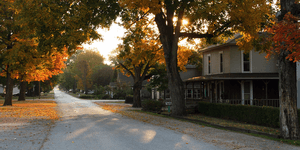
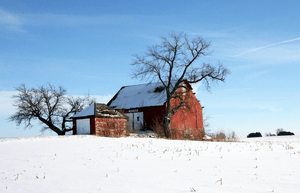
Indiana has a humid continental climate, with cold winters and hot, wet summers.
While droughts occasionally occur in the state, rainfall totals are distributed relatively equally throughout the year.
In a 2012 report, Indiana was ranked eighth in a list of the top 20 tornado-prone states based on National Weather Service data from 1950 through 2011. A 2011 report ranked South Bend 15th among the top 20 tornado-prone cities in the United States, while another report from 2011 ranked Indianapolis eighth. Despite its vulnerability, Indiana is not a part of tornado alley.
Government

Indiana has a constitutional democratic republican form of government with three branches: the executive, including an elected governor and lieutenant governor; the legislative, consisting of an elected bicameral General Assembly; and the judicial, the Supreme Court of Indiana, the Indiana Court of Appeals and circuit courts.
The Governor of Indiana serves as the state's chief executive and has the authority to manage the government as established in the Constitution of Indiana. The governor and the lieutenant governor are jointly elected to four-year terms, with gubernatorial elections running concurrently with United States presidential elections (1996, 2000, 2004, 2008, etc.). The governor may not serve more than two consecutive terms. The governor works with the Indiana General Assembly and the Indiana Supreme Court to govern the state and has the authority to adjust the other branches. The governor can call special sessions of the General Assembly and select and remove leaders of nearly all state departments, boards and commissions. Other notable powers include calling out the Indiana Guard Reserve or the Indiana National Guard in times of emergency or disaster, issuing pardons or commuting the sentence of any criminal offenders except in cases of treason or impeachment and possessing an abundant amount of statutory authority.
The lieutenant governor serves as the President of the Senate and ensures the senate rules are acted in accordance with by its constituents. The lieutenant governor votes only when needed to break ties. If the governor dies in office, becomes permanently incapacitated, resigns or is impeached, the lieutenant governor becomes governor. If both the governor and lieutenant governor positions are unoccupied, the Senate President pro tempore becomes governor.
The Indiana General Assembly is composed of a 50-member Senate and 100-member House of Representatives. The Senate is the upper house of the General Assembly and the House of Representatives is the lower house. The General Assembly has exclusive legislative authority within the state government. Both the Senate and the House can introduce legislation, with the exception that the Senate is not authorized to initiate legislation that will affect revenue. Bills are debated and passed separately in each house, but both houses must pass them before they can be submitted to the Governor. The legislature can nullify a veto from the governor with a majority vote of full membership in the Senate and House of Representatives. Each law passed by the General Assembly must apply without exception to the entire state. The General Assembly has no authority to create legislation that targets a particular community. The General Assembly can manage the state's judiciary system by arranging the size of the courts and the bounds of their districts. It also can oversee the activities of the executive branch of the state government, has restricted power to regulate the county governments within the state, and has exclusive power to initiate the method to alter the Indiana Constitution.
The Indiana Supreme Court is made up of five judges with a Court of Appeals composed of 15 judges. The governor selects judges for the supreme and appeals courts from a group of applicants chosen by a special commission. After serving for two years, the judges must acquire the support of the electorate to serve for a 10-year term. In nearly all cases, the Supreme Court does not have original jurisdiction and can hear only cases petitioned to it after being heard in lower courts. Local circuit courts are where most cases begin with a trial and the consequence is decided by the jury. The Supreme Court has original and sole jurisdiction in certain areas including the practice of law, discipline or disbarment of Judges appointed to the lower state courts, and supervision over the exercise of jurisdiction by the other lower courts of the State.
The state is divided into 92 counties, which are led by a board of county commissioners. 90 counties in Indiana have their own circuit court with a judge elected for a six-year term. The remaining two counties, Dearborn and Ohio, are combined into one circuit. Many counties operate superior courts in addition to the circuit court. In densely populated counties where the caseload is traditionally greater, separate courts have been established to solely hear either juvenile, criminal, probate or small claims cases. The establishment, frequency and jurisdiction of these additional courts vary greatly from county to county. There are 85 city and town courts in Indiana municipalities, created by local ordinance, typically handling minor offenses and not considered courts of record. County officials elected to four-year terms include an auditor, recorder, treasurer, sheriff, coroner and clerk of the circuit court. All incorporated cities in Indiana have a mayor and council form of municipal government. Towns are governed by a town council and townships are governed by a township trustee and advisory board.
Demographics
Population
| Historical population | |||
|---|---|---|---|
| Census | Pop. | %± | |
| 1800 | 2,632 | — | |
| 1810 | 24,520 | 831.6% | |
| 1820 | 147,178 | 500.2% | |
| 1830 | 343,031 | 133.1% | |
| 1840 | 685,866 | 99.9% | |
| 1850 | 988,416 | 44.1% | |
| 1860 | 1,350,428 | 36.6% | |
| 1870 | 1,680,637 | 24.5% | |
| 1880 | 1,978,301 | 17.7% | |
| 1890 | 2,192,404 | 10.8% | |
| 1900 | 2,516,462 | 14.8% | |
| 1910 | 2,700,876 | 7.3% | |
| 1920 | 2,930,390 | 8.5% | |
| 1930 | 3,238,503 | 10.5% | |
| 1940 | 3,427,796 | 5.8% | |
| 1950 | 3,934,224 | 14.8% | |
| 1960 | 4,662,498 | 18.5% | |
| 1970 | 5,193,669 | 11.4% | |
| 1980 | 5,490,224 | 5.7% | |
| 1990 | 5,544,159 | 1.0% | |
| 2000 | 6,080,485 | 9.7% | |
| 2010 | 6,483,802 | 6.6% | |
| 2020 | 6,785,528 | 4.7% | |
| 2024 (est.) | 6,924,275 | 6.8% | |
| Source: 1910–2020 | |||
Indiana recorded a population of 6,785,528 in the 2020 United States census, a 4.65% increase since the 2010 United States census.
The state's population density was 181.0 persons per square mile, the 16th-highest in the United States. As of the 2010 U.S. census, Indiana's population center is northwest of Sheridan, in Hamilton County (+40.149246, −086.259514).
In 2005, 77.7% of Indiana residents lived in metropolitan counties, 16.5% lived in micropolitan counties and 5.9% lived in non-core counties.
According to HUD's 2022 Annual Homeless Assessment Report, there were an estimated 5,449 homeless people in Indiana.
In 2018, The top countries of origin for Indiana's immigrants were Mexico, India, China, Myanmar, and the Philippines.
Religion

Although the largest single religious denomination in the state is Catholic (747,706 members), most Hoosiers are members of various Protestant denominations. The largest Protestant denomination by number of adherents in 2010 was the United Methodist Church, with 355,043. A study by the Graduate Center at the City University of New York found 20% are Catholic, 14% belong to Baptist churches, 10% are other Christians, 9% are Methodist, and 6% are Lutheran. The study found 16% are affiliated with no religion.
Indiana is home to the Benedictine St. Meinrad Archabbey, one of two Catholic archabbeys in the United States and 11 in the world. The Lutheran Church–Missouri Synod has one of its two seminaries in Fort Wayne. Two conservative denominations, the Free Methodist Church and the Wesleyan Church, are headquartered in Indianapolis, as is the Christian Church.
The Fellowship of Grace Brethren Churches maintains offices and publishing work in Winona Lake. Huntington serves as the home to the Church of the United Brethren in Christ. Anderson is home to the headquarters of the Church of God. The headquarters of the Missionary Church is in Fort Wayne.
The Friends United Meeting of the Religious Society of Friends, the largest branch of American Quakerism, is based in Richmond, which also houses the oldest Quaker seminary in the United States, the Earlham School of Religion. The Islamic Society of North America is headquartered in Plainfield.
| Affiliation | % of Indiana population | |
|---|---|---|
| Christianity | 72 |
|
| Protestant | 52 |
|
| Evangelical Protestant | 31 |
|
| Mainline Protestant | 16 |
|
| Black Protestant | 5 |
|
| Catholic | 18 |
|
| Mormon | 1 |
|
| Jehovah's Witnesses | 0.5 |
|
| Orthodox | 0.5 |
|
| Other Christianity | 0.5 |
|
| Judaism | 1 |
|
| Buddhism | 0.5 |
|
| Islam | 0.5 |
|
| Hinduism | 0.5 |
|
| Other faiths | 1 |
|
| Unaffiliated | 26 |
|
| Don't know / No answer | 0.5 |
|
Economy and infrastructure
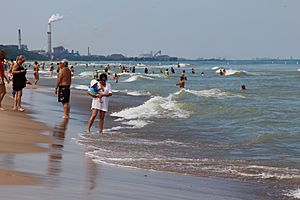
In 2017, Indiana had a civilian labor force of nearly 3.4 million, the 15th largest in the United States. Indiana has an unemployment rate of 3.4%, lower than the national average. The total gross state product in 2016 was $347.2 billion. A high percentage of Indiana's income is from manufacturing. According to the Bureau of Labor Statistics, nearly 17% of the state's non-farm workforce is employed in manufacturing, the highest of any state in the U.S. The state's five leading exports were motor vehicles and auto parts, pharmaceutical products, industrial machinery, optical and medical equipment, and electric machinery.
Despite its reliance on manufacturing, Indiana has been less affected by declines in traditional Rust Belt manufacturers than many of its neighbors. The explanation appears to be certain factors in the labor market. First, much of the heavy manufacturing, such as industrial machinery and steel, requires highly skilled labor, and firms are often willing to locate where hard-to-train skills already exist. Second, Indiana's labor force is primarily in medium-sized and smaller cities rather than in very large and expensive metropolises. This makes it possible for firms to offer somewhat lower wages for these skills than would normally be paid. Firms often see in Indiana a chance to obtain higher than average skills at lower than average wages.
Business
In 2016, Indiana was home to seven Fortune 500 companies with a combined $142.5 billion in revenue. Columbus-based Cummins, Inc. and Indianapolis-based Eli Lilly and Company and Simon Property Group were recognized in Fortune publication's "2017 World's Most Admired Companies List", ranking in each of their respective industries.
Northwest Indiana has been the largest steel producing center in the U.S. since 1975 and accounted for 27% of American-made steel in 2016.
Indiana is home to the international headquarters and research facilities of pharmaceutical company Eli Lilly in Indianapolis, the state's largest corporation, as well as the world headquarters of Mead Johnson Nutritionals in Evansville. Indiana ranks fifth among all U.S. states in total sales and shipments of pharmaceutical products and second in the number of biopharmaceutical related jobs.
Indiana is in the U.S. Corn Belt and Grain Belt. It has a feedlot-style system raising corn to fatten hogs and cattle. Along with corn, soybeans are also a major cash crop. Its proximity to large urban centers, such as Indianapolis and Chicago, assure dairying, egg production, and specialty horticulture occur. Other crops include melons, tomatoes, grapes, mint, popping corn, and tobacco in the southern counties. Most of the original land was not prairie and had to be cleared of deciduous trees. Many parcels of woodland remain and support a furniture-making sector in southern Indiana.
In 2011, CEO magazine ranked Indiana first in the Midwest and sixth in the country for best places to do business.
Taxation
Tax is collected by the Indiana Department of Revenue.
Indiana has a flat state income tax rate of 3.23%. Many of the state's counties also collect income tax. The state sales tax rate is 7% with exemptions for food, prescription medications and over-the-counter medications. In some jurisdictions, an additional Food and Beverage Tax is charged, at a rate of 1% (Marion County's rate is 2%), on sales of prepared meals and beverages.
Property taxes are imposed on both real and personal property in Indiana and are administered by the Department of Local Government Finance. Property is subject to taxation by a variety of taxing units (schools, counties, townships, municipalities, and libraries), making the total tax rate the sum of the tax rates imposed by all taxing units in which a property is located. However, a "circuit breaker" law enacted on March 19, 2008, limits property taxes to 1% of assessed value for homeowners, 2% for rental properties and farmland, and 3% for businesses.
State budget
Indiana does not have a legal requirement to balance the state budget either in law or its constitution. Instead, it has a constitutional ban on assuming debt. The state has a Rainy Day Fund and for healthy reserves proportional to spending. Indiana is one of six U.S. states to not allow a line-item veto.
Since 2010, Indiana has been one of a few states to hold AAA bond credit ratings with the Big Three credit rating agencies, the highest possible rating.
Energy
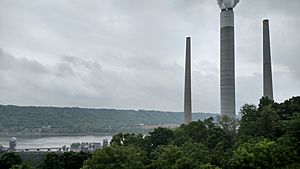
Indiana's power production chiefly consists of the consumption of fossil fuels, mainly coal. It has 24 coal power plants, including the country's largest coal power plant, Gibson Generating Station, across the Wabash River from Mount Carmel, Illinois. Indiana is also home to the coal-fired plant with the highest sulfur dioxide emissions in the United States, the Gallagher power plant, just west of New Albany.
In 2010, Indiana had estimated coal reserves of 57 billion tons, and state mining operations produced 35 million tons of coal annually. Indiana also has at least 900 million barrels of petroleum reserves in the Trenton Field, though they are not easily recoverable. While Indiana has made commitments to increasing the use of renewable resources such as wind, hydroelectric, biomass, or solar power, progress has been very slow, mainly because of the continued abundance of coal in southern Indiana. Most of the new plants in the state have been coal gasification plants. Another source is hydroelectric power.
Wind power has been growing rapidly. Estimates in 2006 raised Indiana's wind capacity from 30 MW at 50 m turbine height to 40,000 MW at 70 m, and to 130,000 MW at 100 m, in 2010, the height of newer turbines. By the end of 2011, Indiana had installed 1,340 MW of wind turbines. In 2020, this total had more than doubled to 2,968 MW.
Transportation
Airports
Indianapolis International Airport serves the greater Indianapolis area. It opened in November 2008 and offers a midfield passenger terminal, concourses, air traffic control tower, parking garage, and airfield and apron improvements.
Other major airports include Evansville Regional Airport, Fort Wayne International Airport (which houses the 122d Fighter Wing of the Air National Guard), and South Bend International Airport. A long-standing proposal to turn Gary Chicago International Airport into Chicago's third major airport received a boost in early 2006 with the approval of $48 million in federal funding over the next ten years.
No airlines operate out of Terre Haute Regional Airport but it is used primarily for general aviation. Since 1954, the 181st Fighter Wing of the Indiana Air National Guard was stationed there, but the Base Realignment and Closure (BRAC) Proposal of 2005 stated the 181st would lose its fighter mission and F-16 aircraft, leaving the Terre Haute facility a general-aviation-only facility.
Louisville International Airport, across the Ohio River in Louisville, Kentucky, serves southern Indiana, as does Cincinnati/Northern Kentucky International Airport in Hebron, Kentucky. Many residents of Northwest Indiana, which is primarily in the Chicago Metropolitan Area, use Chicago's airports, O'Hare International Airport and Chicago Midway International Airport.
Highways
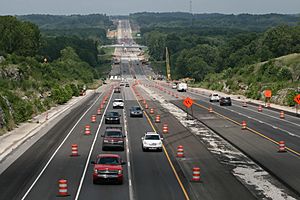
The U.S. Interstate highways in Indiana are I-64, I-65, I-265, I-465, I-865, I-69, I-469, I-70, I-74, I-80, I-90, I-94, and I-275. The various highways intersecting in and around Indianapolis, along with its historical status as a major railroad hub, and the canals that once crossed Indiana, are the source of the state's motto, the Crossroads of America. There are also many U.S. routes and state highways maintained by the Indiana Department of Transportation. These are numbered according to the same convention as U.S. Highways. Indiana allows highways of different classifications to have the same number. For example, I-64 and Indiana State Road 64 both exist (rather close to each other) in Indiana, but are two distinct roads with no relation to one another.
A $3 billion project extending I-69 is underway. The project was divided into six sections, with the first five sections (linking Evansville to Martinsville) now complete. The sixth and final phase from Martinsville to Indianapolis is under construction. When complete, I-69 will traverse an additional 142 miles (229 km) through the state.
County roads
Most Indiana counties use a grid-based system to identify county roads; this system replaced the older arbitrary system of road numbers and names, and (among other things) makes it much easier to identify the sources of calls placed to the 9-1-1 system. Such systems are easier to implement in the glacially flattened northern and central portions of the state. Rural counties in the southern third of the state are less likely to have grids and more likely to rely on unsystematic road names (for example, Crawford, Harrison, Perry, Scott, and Washington Counties).
There are also counties in the northern portions of the state that have never implemented a grid or have only partially implemented one. Some counties are also laid out in an almost diamond-like grid system (e.g., Clark, Floyd, Gibson, and Knox Counties). Such a system is also almost useless in those situations as well. Knox County once operated two different grid systems for county roads because the county was laid out using two different survey grids, but has since decided to use road names and combine roads instead.
Notably, the county road grid system of St. Joseph County, whose major city is South Bend, uses perennial (tree) names (i.e. Ash, Hickory, Ironwood, etc.) in alphabetical order for north–south roads and presidential and other noteworthy names (i.e., Adams, Edison, Lincoln Way, etc.) in alphabetical order for east–west roads. There are exceptions to this rule in downtown South Bend and Mishawaka. Hamilton County's east–west roads continue Indianapolis's numbered street system from 96th Street at the Marion County line to 296th street at the Tipton County line.
Rail
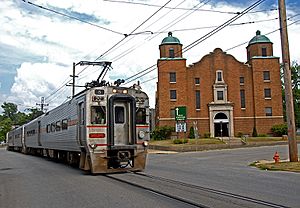
Indiana has more than 4,255 railroad route miles (6,848 km), of which 91% are operated by Class I railroads, principally CSX Transportation and the Norfolk Southern Railway. Other Class I railroads in Indiana include the Canadian National Railway and Soo Line Railroad, a CPKC subsidiary, as well as Amtrak. The remaining miles are operated by 37 regional, local, and switching and terminal railroads. The South Shore Line is one of the country's most notable commuter rail systems, extending from Chicago to South Bend. Indiana is implementing an extensive rail plan prepared in 2002 by the Parsons Corporation. Many recreational trails, such as the Monon Trail and Cardinal Greenway, have been created from abandoned rails routes.
Ports
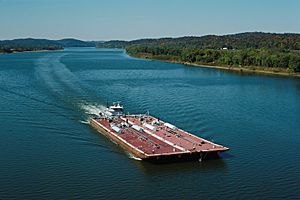
Indiana annually ships more than 70 million tons of cargo by water each year, which ranks 14th among all U.S. states. More than half of Indiana's border is water, which includes 400 miles (640 km) of direct access to two major freight transportation arteries: the Great Lakes/St. Lawrence Seaway (via Lake Michigan) and the Inland Waterway System (via the Ohio River). The Ports of Indiana manages three major ports which include Burns Harbor, Jeffersonville, and Mount Vernon.
Education
Public schools
Indiana's 1816 constitution was the first in the country to implement a state-funded public school system. It also allotted one township for a public university. However, the plan turned out to be far too idealistic for a pioneer society, as tax money was not accessible for its organization. In the 1840s, Caleb Mills pressed the need for tax-supported schools, and in 1851 his advice was included in the new state constitution. In 1843 the Legislature ruled that African Americans could not attend the public schools, leading to the foundation of Union Literary Institute and other schools for them, funded by donations or the students themselves. The Indiana General Assembly authorized separate but equal schools for Black students in 1869, and in 1877 language in the law changed to allow for integrated schools.
Although the growth of the public school system was held up by legal entanglements, many public elementary schools were in use by 1870. Most children in Indiana attend public schools, but nearly ten percent attend private schools and parochial schools. About half of all college students in Indiana are enrolled in state-supported four-year schools.
Indiana public schools have gone through several changes throughout Indiana's history. Modern, public school standards, have been implemented all throughout the state. These new standards were adopted in April 2014. The overall goal of these new state standards is to ensure Indiana students have the necessary skills and requirements needed to enter college or the workforce upon high school graduation. State standards can be found for nearly every major subject taught in Indiana public schools. Mathematics, English/Language Arts, Science, and Social Studies are among the top, prioritized standards. In 2022, the Indiana Department of Education reported that the state's overall graduation rate was 86.7%, down one percent from 2021.
The rate of Indiana high school students attending college fell to 53% in 2022, a significant decline from 65% in 2017. Indiana's college-going rates have fallen further than most states'. Trends reveal widening gaps for ethnic minorities and low-income families.
Vocational schools
Indiana has a strong vocational school system. Charles Allen Prossor, known as the father of vocational education in the United States, was from New Albany. The Charles Allen Prosser School of Technology is named in his honor. There are vocational schools in every region of Indiana, and most Indiana students can freely attend a vocational school during their high school years and receive training and job placement assistance in trade jobs. The International Union Of Operating Engineers (IUOE) has seven local unions in Indiana, offering apprenticeship and training opportunities. According to the Electrical Training Alliance website, there are ten electrical training centers in Indiana.
Colleges and universities
The state's community college system, Ivy Tech Community College of Indiana, serves nearly 200,000 students annually, making it the state's largest public post-secondary educational institution and the nation's largest singly accredited statewide community college system. In 2008, the Indiana University system agreed to shift most of its associate (2-year) degrees to the Ivy Tech Community College System.
The largest non-community educational institution is Indiana University, a multi-campus university system; its flagship campus at Bloomington was endorsed as the Indiana Seminary in 1820. Indiana State University was established in Terre Haute as the state's Normal School in 1865. Purdue University was chartered in West Lafayette as the state's land-grant university in 1869 and is also now a multi-campus institution. The three other independent state universities are Vincennes University (founded in 1801 by the Indiana Territory), Ball State University (founded 1918 as the East Division of Indiana State), and the University of Southern Indiana (founded 1965 as the Evansville campus of Indiana State).
Many of Indiana's private colleges and universities are affiliated with religious groups. The University of Notre Dame, Marian University, and the University of Saint Francis are popular Roman Catholic schools. Universities affiliated with Protestant denominations include Anderson University, Butler University, Huntington University, Manchester University, Indiana Wesleyan University, Taylor University, Franklin College, Hanover College, DePauw University, Earlham College, Valparaiso University, University of Indianapolis, and University of Evansville.
The state has several universities ranked among the best by U.S. News & World Report. The University of Notre Dame ranks among the top 20, Purdue University among the top 50, and Indiana University Bloomington among the top 100. Indiana University–Purdue University Indianapolis (IUPUI) has recently made it into the top 200 U.S. News & World Report rankings. Butler, Valparaiso, and the University of Evansville are ranked among the top ten in the Regional University Midwest Rankings. Purdue's engineering programs are ranked fourth in the country. In addition, Taylor University is ranked first in the Regional College Midwest Rankings and Rose-Hulman Institute of Technology has been considered the nation's top undergraduate engineering school for 25 consecutive years.
The state is also home to the largest medical school system in the country (the Indiana University School of Medicine) and a smaller, osteopathic medical school (the Marian University College of Osteopathic Medicine). In addition, Indiana boasts one veterinary medical school (the Purdue College of Veterinary Medicine), one optometry school (Indiana University School of Optometry), three pharmacy schools (the Purdue College of Pharmacy, Butler College of Pharmacy and Health Sciences, and the Manchester College of Pharmacy, Natural, and Health Sciences) and four law schools (IU Maurer School of Law, IU McKinney School of Law, Notre Dame Law School, and Purdue Global Law School).
Culture
Arts
The last decades of the 19th century began what is known as the "golden age of Indiana literature", a period that lasted until the 1920s. Edward Eggleston wrote The Hoosier Schoolmaster (1871), the first best-seller to originate in the state. Many more followed, including Maurice Thompson's Hoosier Mosaics (1875) and Lew Wallace's Ben-Hur (1880). Indiana developed a reputation as the "American heartland" after the publication of several widely read novels, beginning with Booth Tarkington's The Gentleman from Indiana (1899), Meredith Nicholson's The Hoosiers (1900), and Thompson's Alice of Old Vincennes (1900). James Whitcomb Riley, known as the "Hoosier Poet" and the most popular poet of his age, wrote hundreds of poems with Hoosier themes, including Little Orphant Annie. A unique art culture also began to develop in the late 19th century, beginning the Hoosier School of landscape painting and the Richmond Group of impressionist painters. The painters, including T. C. Steele, whose work was influenced by southern Indiana's colorful hills, were known for their use of vivid colors. Prominent musicians and composers from Indiana also reached national acclaim, including Paul Dresser, whose most popular song, "On the Banks of the Wabash, Far Away", was later adopted as the official state song.
Sports
Motorsports
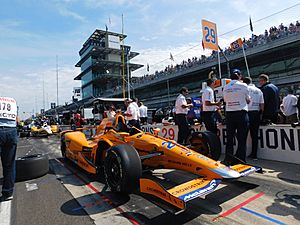
Indiana has an extensive history with auto racing. Indianapolis hosts the Indianapolis 500 mile race over Memorial Day weekend at the Indianapolis Motor Speedway every May. The name of the race is usually shortened to "Indy 500" and also goes by the nickname "The Greatest Spectacle in Racing". The race attracts more than 250,000 people every year, making it the largest single-day sporting event in the world. The track also hosts the Brickyard 400 (NASCAR) and the Red Bull Indianapolis Grand Prix. From 2000 to 2007, it hosted the United States Grand Prix (Formula One). Indiana features the world's largest and most prestigious drag race, the NHRA Mac Tools U.S. Nationals, held each Labor Day weekend at Lucas Oil Raceway at Indianapolis in Clermont, Indiana. Indiana is also host to a major unlimited hydroplane racing power boat race circuits in the major H1 Unlimited league, the Madison Regatta (Madison, Indiana).
Professional sports
As of 2013[update] Indiana has produced more National Basketball Association (NBA) players per capita than any other state. Muncie has produced the most per capita of any American city, with two other Indiana cities in the top ten. It has a rich basketball heritage that reaches back to the sport's formative years. The NBA's Indiana Pacers play their home games at Gainbridge Fieldhouse; they began play in 1967 in the American Basketball Association (ABA) and joined the NBA when the leagues merged in 1976. Although James Naismith developed basketball in Springfield, Massachusetts in 1891, high school basketball was born in Indiana. In 1925, Naismith visited an Indiana basketball state finals game along with 15,000 screaming fans and later wrote "Basketball really had its origin in Indiana, which remains the center of the sport." The 1986 film Hoosiers is inspired by the story of the 1954 Indiana state champions Milan High School. Professional basketball player Larry Bird was born in West Baden Springs and was raised in French Lick. He went on to lead the Boston Celtics to the NBA championship in 1981, 1984, and 1986.
Indianapolis is home to the Indianapolis Colts. The Colts are members of the South Division of the American Football Conference. The Colts have roots back to 1913 as the Dayton Triangles. They became an official team after moving to Baltimore, MD, in 1953. In 1984, the Colts relocated to Indianapolis, leading to an eventual rivalry with the Baltimore Ravens. After calling the RCA Dome home for 25 years, the Colts play their home games at Lucas Oil Stadium in Indianapolis. While in Baltimore, the Colts won Super Bowl V. In Indianapolis, the Colts won Super Bowl XLI, bringing the franchise total to two. In recent years the Colts have regularly competed in the NFL playoffs.
Indiana was home to two charter members of the National Football League teams, the Hammond Pros and the Muncie Flyers. Another early NFL franchise, the Evansville Crimson Giants spent two seasons in the league before folding.
Professional teams
The following table shows the professional sports teams in Indiana. Teams in italic are in major professional leagues.
| Club | Sport | League | Venue (capacity) |
|---|---|---|---|
| Indianapolis Colts | American football | National Football League | Lucas Oil Stadium (62,400) |
| Indiana Pacers | Basketball | National Basketball Association | Gainbridge Fieldhouse (18,165) |
| Evansville Otters | Baseball | Frontier League | Bosse Field (5,181) |
| Evansville Thunderbolts | Ice hockey | SPHL | Ford Center (9,000) |
| Fort Wayne Komets | Ice hockey | ECHL | Allen County War Memorial Coliseum (10,480) |
| Fort Wayne TinCaps | Baseball | High-A Central | Parkview Field (8,100) |
| Gary SouthShore RailCats | Baseball | American Association | U.S. Steel Yard (6,139) |
| Indiana Fever | Basketball | Women's National Basketball Association | Gainbridge Fieldhouse (18,165) |
| Indiana Mad Ants | Basketball | NBA G League | Gainbridge Fieldhouse (18,165) (Noblesville Event Center (3,400) in 2025–26) |
| Indy Eleven | Soccer | United Soccer League | Michael A. Carroll Stadium (10,524) |
| Indy Fuel | Ice hockey | ECHL | Indiana Farmers Coliseum (6,300) |
| Indianapolis Indians | Baseball | Triple-A East | Victory Field (14,230) |
| Indianapolis Enforcers | Arena football | AAL | Indiana Farmers Coliseum |
| South Bend Cubs | Baseball | High-A Central | Four Winds Field (5,000) |
The following is a table of sports venues in Indiana having a capacity in excess of 30,000:
| Facility | Capacity | Municipality | Tenants |
|---|---|---|---|
| Indianapolis Motor Speedway | 257,327 | Speedway |
|
| Notre Dame Stadium | 84,000 | Notre Dame | Notre Dame Fighting Irish football |
| Lucas Oil Stadium | 62,421 | Indianapolis | Indianapolis Colts |
| Ross–Ade Stadium | 57,236 | West Lafayette | Purdue Boilermakers football |
| Memorial Stadium | 52,929 | Bloomington | Indiana Hoosiers football |
College athletics
Indiana has had great sports success at the collegiate level.
In men's basketball, the Indiana Hoosiers have won five NCAA national championships and 22 Big Ten Conference championships. The Purdue Boilermakers were selected as the national champions in 1932 before the creation of the tournament, and have won 26 Big Ten championships. The Boilermakers along with the Notre Dame Fighting Irish have both won a national championship in women's basketball.
In college football, the Notre Dame Fighting Irish have won 11 consensus national championships, as well as the Rose Bowl Game, Cotton Bowl Classic, Orange Bowl and Sugar Bowl. Meanwhile, the Purdue Boilermakers have won 10 Big Ten championships and have won the Rose Bowl and Peach Bowl.
Schools fielding NCAA Division I athletic programs include:
| Program | Division | Conference | City |
|---|---|---|---|
| Ball State Cardinals | Division I-FBS | Mid-American Conference | Muncie |
| Butler Bulldogs | Division I-FCS | Big East Conference
Pioneer Football League |
Indianapolis |
| Evansville Purple Aces | Division I (non-football) | Missouri Valley Conference | Evansville |
| Indiana Hoosiers | Division I-FBS | Big Ten Conference
Mountain Pacific Sports Federation (women's water polo) |
Bloomington |
| Indiana State Sycamores | Division I-FCS | Missouri Valley Conference | Terre Haute |
| IUPUI Jaguars | Division I (non-football) | Horizon League | Indianapolis |
| Notre Dame Fighting Irish | Division I-FBS | Atlantic Coast Conference
Big Ten Conference (men's ice hockey) Independent (football) |
South Bend |
| Purdue Boilermakers | Division I-FBS | Big Ten Conference | West Lafayette |
| Purdue Fort Wayne Mastodons | Division I (non-football) | Horizon League | Fort Wayne |
| Southern Indiana Screaming Eagles | Division I (non-football) | Ohio Valley Conference
Summit League (men's soccer, men's swimming, women's swimming) Horizon League (men's tennis) |
Evansville |
| Valparaiso Beacons | Division I-FCS | Missouri Valley Conference
Pioneer Football League Summit League (men's swimming) Southland Bowling League (women's bowling) |
Valparaiso |
See also
 In Spanish: Indiana para niños
In Spanish: Indiana para niños



